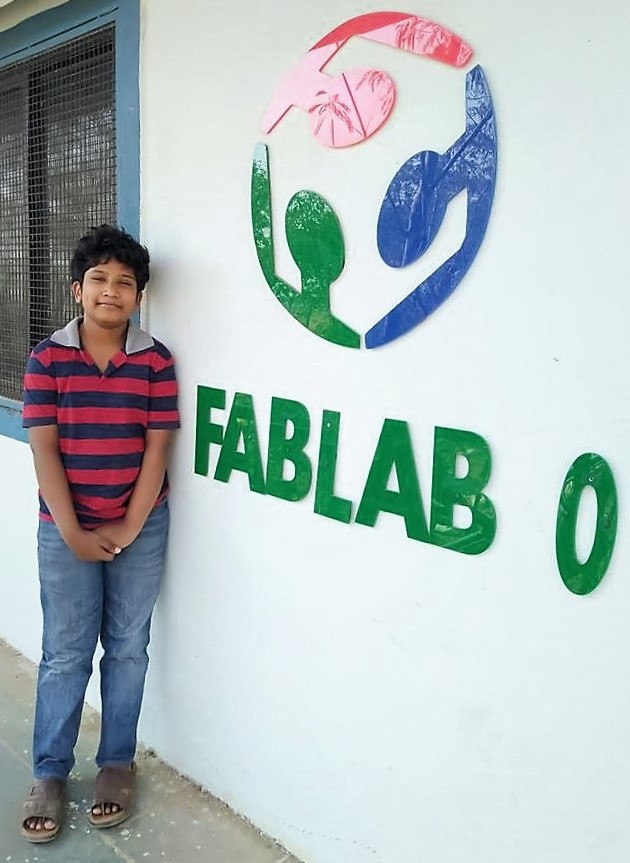Group Assignment
There is no Group Assignment. We have done one
during the Mechanical Design week, a Cablebot.
Individual Assignment
I am presenting My Smart FAB Air Cooler to you as my Final Project of my
journey in Digital Fabrication during the Fab Academy Diploma Program
2019.
Genesis - In Fab Lab O, the heat is unbearable and there is a regular and untimely power outage. So initially when I wanted to make an EBYKE, the Director told me to make an air cooler for my final project. Then I started researching on this subject. The human body considered as thermal machine with 20% thermal efficiency. The remaining 80% heat must be disposed of from the body to the surroundings otherwise the accumulation of heat results and causes discomfort. The human body works best at a particular body temperature like any other machine but cannot tolerate wide range of variation in environmental temperature like thermodynamic machines.
Problem - The producing of electricity is ultimately responsible for hot and humid conditions, i.e., global warming. It is clear that major quantity of electricity is produced by coal (fossil fuel). The Fossil fuels also contain radioactive materials, mainly uranium and thorium, which are released into the atmosphere. The Electricity generation produces nitrogen oxides and Sulphur dioxide emissions, which contribute to smog and acid rain, emit carbon dioxide, which may contribute to climate change. The longer power cut durations in villages and high cost of cooling products.
Proposed Solution - Need of such a source which is abundantly available in nature, which does not impose any bad effects on earth. There is only one thing which can come up with these all problems is solar energy. Solar energy, radiant light and heat from the sun, is harnessed using a range of technologies such as solar heating, solar photovoltaics. The Earth receives 174 petawatts (PW) of incoming solar radiation. Approximately 30% is reflected back to space while the rest is absorbed by clouds, oceans and land masses. Photovoltaics is a method of generating electrical power by converting solar radiation into direct current electricity by photovoltaic effect.
Need - Human beings give off heat, around an average of 100 kcal per hour per person, due to what is known as ‘metabolism’. The temperature mechanism within the human body maintains a body temperature of around 36.90 C (98.40 F). But the skin temperature varies according to the surrounding temperature and relative humidity. To dissipate the heat generated by metabolism in order to maintain the body temperature at the normal level, there must be a flow of heat from the skin to the surrounding air.
If the surrounding temperature is slightly less than that of the body, there will be steady flow of heat from the skin. But is the surrounding temperature is very low, as on cold winter day the rate of heat flow from the body will be quite rapid, thus the person feels cold, on the other hand on a hot summer day, the surrounding temperature is higher than that of the body, and so there cannot be flow of heat from the skin to the surroundings, thus the person feels hot. In such a situation water from the body evaporates at the skin surface dissipating water from the body evaporates at the skin surface dissipating the heat due to metabolism. This helps in maintaining normal body temperature. But if the surrounding air is not only hot but highly humid as well, very little evaporation of water can take place from the skin surface, and so the person feels hot and uncomfortable.
Thermoregulation - The body tightly regulates the body temperature through a process called thermoregulation, in which the body can maintain its temperature within certain boundaries, even when the surrounding temperature is very different. The core temperature of the body remains steady at around 36.5–37.5 °C (or 97.7–99.5 °F).
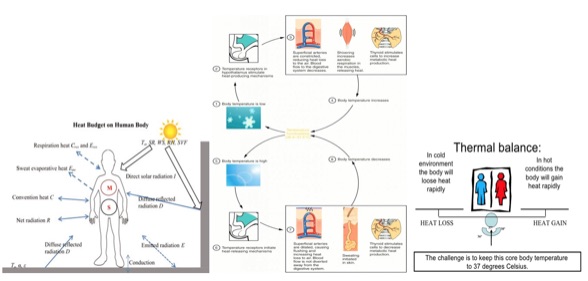
The human body works best at certain temperatures like other machines, but it cannot tolerate with range of variations. The human body maintains its thermal equilibrium by three modes of heat transfer i.e. evaporation, radiation and convection. A human body feels comfortable when the heat produced by metabolism of human body is equal to the sum of heat dissipated to the surroundings. The normal temperature of the human body is 37 degrees C or 98.6 degrees F. But, if this level goes below 36.5 degrees F or 98 degrees F and exceeds 40.5 C or 105 degrees F the conditions become dangerous for human existence.
Factors Effecting Human Comfort - The conditions become dangerous for human existence if the temperature is rising beyond 40 degrees C. The important factors while designing any system of comfort are
♣ Effective Temperature
♣ Heat Production & Regulation in Human Body
♣ Heat and Moisture losses from the body
♣ Moisture Content of the Air
♣ Quality and Quantity of Air
♣ Air Motion
♣ Air Stratification
Physiological Hazards Resulting from Heat and are -
♣ Heat Exhaustion
♣ Heat Cramps
♣ Heat Stroke
♣ Hypothermia
Review of Literature – In 2019 the International Labor Organization (ILO) estimated that by 2030 the global economy would suffer lost productivity worth USD 2.4 trillion annually due to heat stress, the equivalent of 80 million full-time jobs. With reference to the UNSDG 13 Climate Action, “The Cooling for All initiative” created to explore opportunities to incorporate methods to satisfy growing cooling demands for all sectors of society into the global clean energy transition. The initiative focuses on increasing efficiency for all aspects of cooling solutions, from cold supply chains for food and medicines to maintaining safe work and educational environments that increase productivity. In the aggregate, these are alarming figures. But they also belie the disproportionate impact on developing economies experiencing increasing heat stress, and the long-term impact heat stress will have on economic growth. It will be these countries, and the sectors that support their growth, that face the most significant productivity penalty due to a lack of access to sustainable cooling.
The analysis suggests that across 54 high-impact countries, the estimated annual economic loss due to heat stress is currently USD 630 billion, including USD 301 billion in the agricultural sector alone. This includes 318 million people living in poor rural areas and 699 million living in poor urban areas. A further 2.2 billion lower-middle income people pose a different kind of risk: limited purchasing choices mean they are likely to favor cooling devices that are typically inefficient and could cause a dramatic rise in energy demand and associated emissions. In Africa, the rural poor population continues to grow, to 204 million in 2020, whereas in Asia, the number of urban poor continues to grow, up to 484 million people in 2020.
The work of the initiative supports the objectives of the Paris Agreement on climate change, the Sustainable Development Goals, and the Montreal Protocol’s Kigali Amendment, which aims to limit hydro flouro carbon (HFC) production. HFCs are widely used in air conditioners and refrigerators as a substitute for ozone-harming cloro flouro carbons (CFCs), however they are also potent greenhouse gases.
Every country draws its energy needs from a variety of sources. We can broadly categorize these sources as commercial and noncommercial. The commercial sources include the fossil fuels (coal, oil and natural gas), hydroelectric power and nuclear power, while the non-commercial sources include wood, animal wastes, geothermal energy and agricultural wastes. The use of commercial energy has led to a better quality of life it has also created many problems. Perhaps the most serious of these is the harmful effect on the environment. The combustion of the fossil fuel has caused serious air pollution problems in many areas because of the localized release of large amounts of harmful gases into the atmosphere. It has also resulted in the phenomenon of global warming, which is now a matter of great concern. The gravity of these environmental problems embarks on the search for alternative sources of energy, it is clear that they would do well to keep the environment in mind.
Non - Conventional Energy – In the UNSDG 13 – Climate Action, there is also a goal dedicated to “Energy”. This is a pledge to: “Ensure access to affordable, reliable, sustainable and modern energy for all.” This, too, comes with five associated goals. These are:
1. 7.1 by 2030 ensure universal access to affordable, reliable and modern energy services.
2. 7.2 by 2030 increase substantially the share of renewable energy in the global energy mix.
3. 7.3 by 2030 double the global rate of improvement in energy efficiency.
4. 7. A by 2030, enhance international cooperation to facilitate access to clean energy research and technology, including renewable energy, energy. Efficiency and advanced and cleaner fossil-fuel technology, and promote investment in energy infrastructure and clean energy technology.
5. 7.B by 2030, expand infrastructure and upgrade technology for supplying modern and sustainable energy services for all in developing countries, in particular least developed countries, small island developing States and landlocked developing countries, in accordance with their respective programs of support.
As it’s estimated that the Fuel deposits in the will soon deplete by the end of 2045, fuel scarcity will be at the maximum. In a country like India in view of this alarming situation in mind I tried to make use of non-pollutant natural resource of solar energy. The creation of new source of perennial environmentally acceptable, low cost electrical energy as a replacement for energy from rapidly depleting resources of fossil fuels is the fundamental need for the survival of mankind. As per the reports, it’s forecasted that we have only about 25 years of oil reserves and 75 – 100 years of coal reserves. Resort to measure beginning of coal in thermal electric stations to serve the population would result in global elemental change in leading to worldwide drought and decertification. Solar power stations provide a cost-effective solution even though works on solar photo voltaic and solar thermos-electric energy sources have been extensively pursued by many countries.
Hence I chose this Solar FAB Air Cooler as My Final Project.
Objective of the Project - I wanted to create awareness about the use of non-conventional energy sources and to reduce environmental pollution in context to the UNSDG 13 – Climate Action. This product is preferably suitable for villages, because they face lot of power cut problems in summer around 12 to 14 hours in a day and for offices and schools which runs in day to which save energy. As air-conditioning consumes more power and mainly cost of air conditioning products are very high. So I have developed My Solar FAB Air Cooler which runs by solar energy and provides cooling effect for the room at a lower cost.
The Goal was to build a Solar FAB Air Cooler. In a warming world, access to sustainable cooling is not a luxury. My Mission is to generate the evidence, partnerships, and policy business solutions necessary to provide sustainable cooling for all and to reduce the energy demand needed to achieve this. I want to show what can be done to make Sustainable Cooling a Reality.
The Target Group - Across the 54 high-impact countries, 1.02 billion people among the rural and urban poor remain at high risk in 2020. This includes the 318 million people living in poor rural areas and 699 million living in poor urban areas. A further 2.2 billion lower-middle income people pose a different kind of risk: limited purchasing choices. It means that they are likely to favor cooling devices that are typically inefficient and could cause a dramatic rise in energy demand and associated emissions. So as a Solution to address the dimensions of sustainable cooling for all, the Population category I’m targeting for my Final Project is as follows.
1. The Urban Poor
2. The Lower-Middle Income, and
3. 1. The Middle Income.
Ideate to Create –
Aim –I want to improve the awareness and improve the human capacity on mitigation, impact reduction and early warning in adaptation to the Climate Change. The sustainable and affordable cooling system does not mean that every home should have an air conditioner and a refrigerator. It means we should focus on affordable cooling technology and sustainable cooling solutions to address the needs of the most vulnerable population. So, this sustainable and transformative cooling for all eco idea highlights the climate friendly solution to provide protection from heat in the transition to affordable and clean energy. Here is my idea to show what can be done to make Sustainable Cooling a Reality.
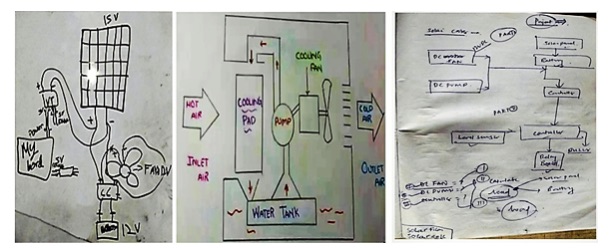 Working Methodology –
Working Methodology – Solar Energy Conversion and Cool Air generation by the Centrifugal Fan.
Digital Fabrication Tools and Techniques used apart from the power tools for the Final Project –
| SL.No |
Tools |
Techniques |
| 1 |
Laser Cutter |
2D and 3D Design |
| 2 |
Temperature Sensor Holder |
3D Prining |
| 3 |
SRM 20 |
PCB milling |
| 4 |
Eagle |
PCB Design |
| 5 |
Slicer for Fusion |
Chamfer Design |
| 6 |
Vinyl Cutting |
Inkscape |
| 7 |
AUTODESK Fusion 360 |
3D Design |
PCB for the Final Project –
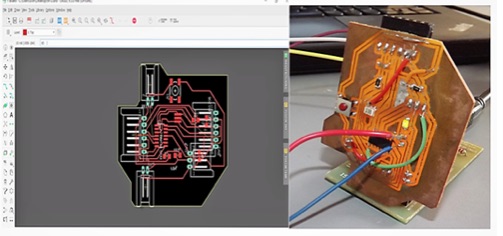
I had an issue with my pcb as it did not integrate with the program, so
I made an ATMega328PAU.
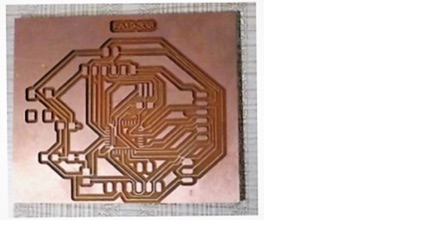
But the ATTiny44 worked. Hence dint solder it.
Smart FAB Air Cooler Body Parts

 Electronic Input –
Electronic Input – HC05 Bluetooth Module and LM35 Temperature Sensor
Electronic Output – Relay and DC Fan 12v
Control Board – ATTiny44
Steps I have followed:
1. LM35 Analog Read from ATTiny44.
2. Attach a Bluetooth Module.
3. Use Serial Communication to send Data over RX and TX.
4. Create an App Inventor to the App in order to connect to the
Bluetooth.
Final Project Assembly –I have assembled all the parts made and procured in the Fab Lab and started testing the model


Modules Reference –
Principles and Practices
Computer Aided Design
3D Modelling, Scanning and Printing
Wild Card Week
Input Device
Output Device
Embedded Programming
Network and Communication
Applications and Implications
Interface and
Applications
Project Development
Time Management – I am happy that I could utilize my time effectively,
as I have done most of my final project work during the weekly
assignments as mentioned above. I had time to explore new ideas in the
given schedule. The Gantt chart below shows my final project timeline.
Gantt chart of My Final Project
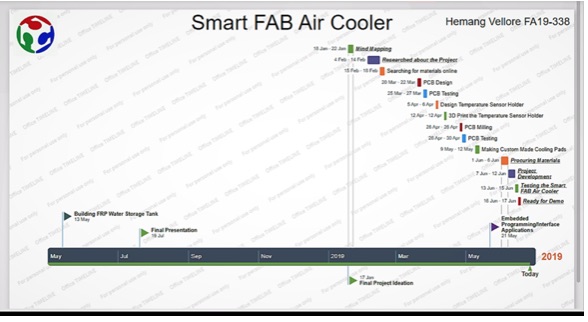
Now I present My Smart FAB Air Cooler –
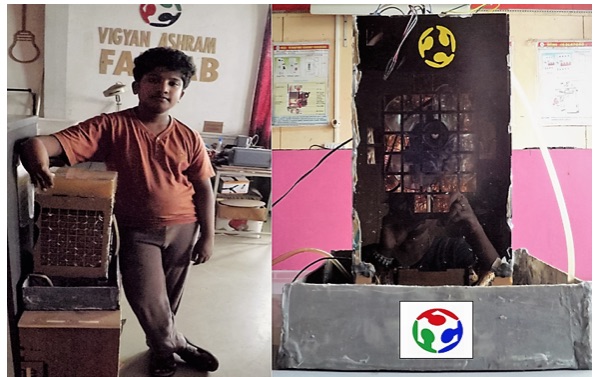
Final Presentation Slide for Prof. Neil Adam Gershenfeld –
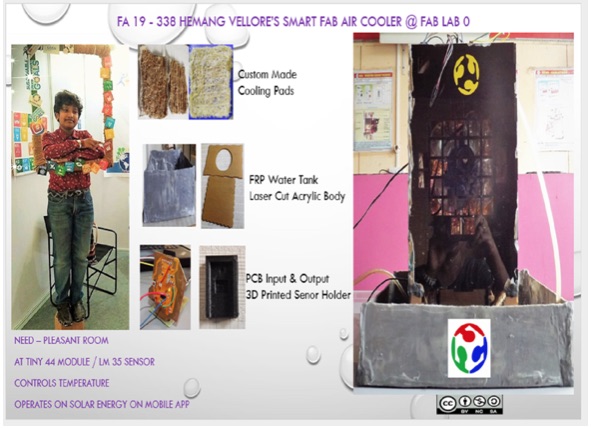 Final Presentation Video – https://youtu.be/VwgVdaWnTmY
Modified version of the Final Project Presentation -
Final Presentation Video – https://youtu.be/VwgVdaWnTmY
Modified version of the Final Project Presentation -

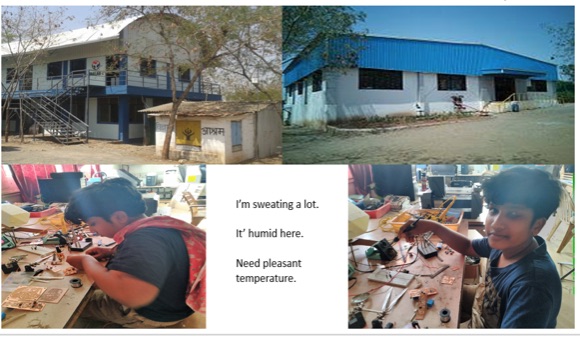

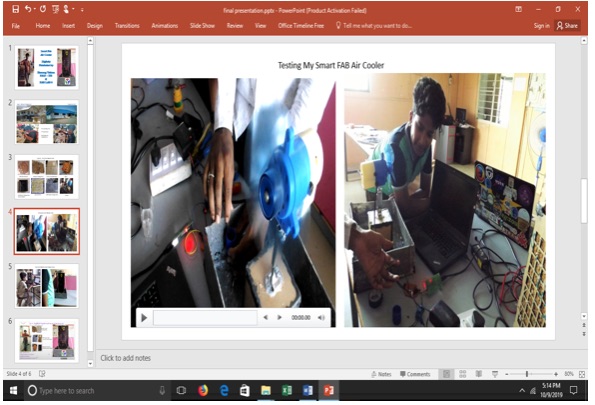
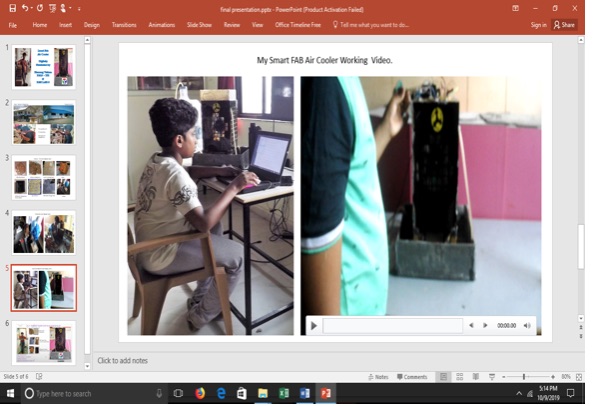
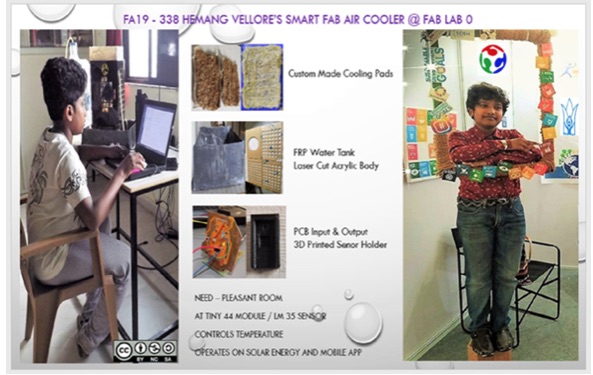
As seen in the picture above, I have connected My Smart Fab Air Cooler
to the Water Bubble Top with a Plastic Tube to ensure continuous smooth
water flow, as the FRP water tank has a limited capacity for water
storage which works for 30 hours in test condition.
My Final Presentation with Prof. Neil Adam Gershenfeld
 Learning Outcome –
Learning Outcome –
1. Project Management.
2. Importance of Time schedule during the assignments.
3. My first Website to making a PCB.
4. Learning Software and Working on the related Hardware.
5. Amalgamation of learning during the process.
6. Glad to see my product – Smart FAB Air Cooler.
Credits –
I am obliged and value FAB ACADEMY for enabling me to do this Digital
Fabrication Diploma Program by awarding me 80% scholarship.
I recognize FAB LAB 0’s choice and respect their decision to welcome me
to join this cohort.
My sincere gratitude to my Mentors and appreciate the Team for guiding
me through this education.
I would always treasure my beloved parents’ belief and trust in extended
their unflinching support to experience this wonderful learning curve.
I also thank the FAB ACADEMY archives and Internet as my online guide in
documenting my assignments.
I am touched beyond words for all those people who have made a
difference through their reach out and trolls in this journey.
A Thank You is not enough; I would always cherish these learnings to
enable me to perform better in my future endeavors.
Sometimes the simplest things mean the most. Gracias! Salute! Namaste!
